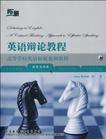英语辩论教程
出版时间:2010-4 出版社:外语教学与研究出版社 作者:莱博德 页数:184
Tag标签:无
前言
Technology and globalization have spread opportunities around the world.Yet these same forces have also brought about changes at an unprecedented pace.Peter Lyman of the UC Berkeley School of Information warns that“with the amount of stored information growing at a rate of about 30%a year,a real change in our human ecology is taking place.Specialized knowledge is updated SO often that it has a half-life-the time a piece of information stays current——as short as five years". Even with this quickly changing environment students are still rewarded for memorizing information that will soon be outdated.Worse yet,students cram for exams and as soon as the test is over they forget most ofwhat they“knew." Specifically,in language instruction we can be“left with verbalismJ whereby learners do nothing more than 1isten to lecturesJ take notes,and memorize abstract definitions.If language instruction is limited to this type of activity, conceptual knowledge will have no power to be generalized to specific concrete communicative situations and will essentially be useless". Debating in English strives to be different from this type of education.Of course,you will need to learn concepts in this book.But these concepts should not be treated as checkmarks for taking an exam.Instead you need to participate in activities to make these concepts part ofwho you are,SO that you can be a better thinker and a better speaker in English.
内容概要
本书作者从丰富的国内外英语辩论培训经验出发,针对中国学习者在辩论方面的需求和特点,介绍了辩论的基本知识和技巧,重在通过培养思辨能力帮助学习者提高辩论及沟通技能,在语言与观点的交锋中锤炼思维,开阔视野。 选材精要,涉及辩论形式、评判规则、思辨技巧、陈词技巧、资料收集、辩题分析、立论驳论等基本内容。 内容讲解清晰简洁,辅以具体的举例说明,易于理解掌握。 活动设计易于操作,以小见大,针对性强。 以思辨方法和技巧的培养与运用为切入点,促进学习者辩论水平及思维能力的提高。 配套教学资源丰富。随书所附DVD包含国内最为普及的两种辩论形式的录像。更多教学资源及辩论录像将通过高等英语教学网陆续提升。
书籍目录
Chapter 1 Welcome to DebateChapter 2 Fundamentals of DebateChapter 3 Critical thinking in DebateChapter 4 Developing Effective Public Speaking SkillsChapter 5 Impromptu and Extemporaneous SpeakingChapter 6 Listening and FlowingChapter 7 Motions Chapter 8 ResearchingChapter 9 Propositional Case DevelopmentChapter 10 Oppositional Counter-case DevelopmentChapter 11 Refutation and RejoinderChapter 12 Logical FallaciesChapter 13 Competing in Debate TournamentsAppendices Appendix 1 Glossary of Debate Terms Appendix 2 Fallacy List Appendix 3 How to Conduct a Debate Tournament
章节摘录
Hierarchy of values.Any motion being debated could involve many different values.Some of these values might be in conflict with each othe which means the values cannot all be achieved equally at the same time.If they are in conflict,the propositional team should set up a hierarchy of values within the framework of the context or in the order of importance.In terms of our example on technologv the highest value could be"naximizing the learning of the students."However,if PPT is used in an oral English classroom,a conflicting value may be PPT is"easier for the teacher to lecture:If the students find the PPT lecture unengaging,we need to ask in the context of an oraI communication class:Which is a higher value-ease of lecturing for the teacher,or engagement of the students for maximizing the learning. Criteria.Once the hierarchy is established,how will we know whether it is met or not?In the above example,how much involvement is necessary for students to have a better educational experience for developing oral communication sldlls? This criterion could be established in a manner that points in a direction such as anything that reduces student discussion would lessen the educational experience.Another approach is to establish how much time should be spent in lecturing and how much time spent in activities.If the evidence says at least a 50%involvement is best for learningJ then anything less caused by technology would 1essen the educational experience.
图书封面
图书标签Tags
无
评论、评分、阅读与下载
用户评论 (总计22条)
- 全是英文 就是大概介绍了一下英语辩论的过程 对辩论本身没有什么提高
- 一本适合英语专业辩论的好书!
- 经典的辩论教程,可以作为教材参考书,需要仔细研读。
- 对辩论的基础比较有帮助!
- 唉 英语课要用的课本 看起来还不错哈
- 内容丰富,图书的质量很好!
- 内容不错撒
- 虽然有一些生词,但是看得很开心!学到了很多!
- 还可以,价格偏贵
- 不错。初一的孩子上课用。老师推荐。
- 准备阅读~
- 老师让买的,应该还不错
- 还不错吧,全英文的
- 需要时间慢慢读。
- 很适合辩手们哦
- 解题思路点拨到位 答案精准权威
- 很好,谢谢当当,请多些此类带光碟的关于英语辩论的书籍.
- 书不错,当辩论入门书读了。
- 对我有帮助,回头仔细看看
- 挺好的,轻便
- 买回来才发现是英文版,粗心了。
感觉这么本书并没有对辩论的技巧讲的很到位,例子也少。
没想象的好 - 一大堆术语,解释的有点乱
而且本书介绍的辩论和一般想的辩论有点不一样
总觉得不够专业
